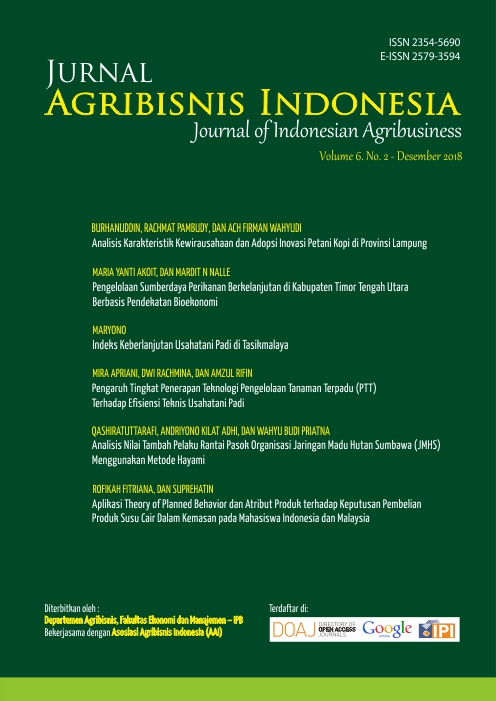PENGARUH TINGKAT PENERAPAN TEKNOLOGI PENGELOLAAN TANAMAN TERPADU (PTT) TERHADAP EFISIENSI TEKNIS USAHATANI PADI
Main Article Content
Abstract
Downloads
Article Details
Jurnal Agribisnis Indonesia (JAI) is an Open Access Journal. The authors who publish the manuscript in this journal agree to the following terms:
Creative Commons License
JAI is licensed under a Creative Commons Attribution 4.0 International License. This permits anyone to copy, redistribute, remix, transmit, and adapt the work provided the original work and source are appropriately cited.
This means:
(1) Under the CC-BY license, authors retain ownership of the copyright for their article, but authors grant others permission to use the content of publications in Jurnal Agribisnis Indonesia in whole or in part provided that the original work is properly cited. Users (redistributors) of JAI are required to cite the original source, including the author's name, JAI as the initial source of publication, year of publication, volume number, issue, and Digital Object Identifier (DOI); (2) Authors grant JAI the right of first publication. Although authors remain the copyright owner.
References
Bhatt MS, Bhat SA. 2014. Technical Efficiency and Farm Size Productivity Micro Level Evidence From Jammu and Kashmir. International Journal of Food and Agricultural Economics. 2(4):27-49.
[BPS]. Badan Pusat Statistik. 2016. Produksi Padi Menurut Provinsi (Ton) 1993-2015. [Internet]. [Diunduh 25 November 2017]. Tersedia pada: https://www.bps.go.id/linkTableDinamis/view/id/865.
Coelli TJ. 1996. A Guide to FRONTIER Version 4.1. A Computer Program for Stochastic Frontier Production Function and Cot Function Estimation Centre for Efficiency and Productivity. Armidale (AU): University of NewEngland.
Essilfie FL, Maxwell T, Asiamah, Nimoh F. 2011. Estimation of Farm Level Technical Efficiency in Small Scale Maize Production in the Mfantseman Municipality in the Central Region of Ghana: A Stochastic Frontier Approach. Journal of Development and Agricultural Economics. 3(14):645-654.
Fatima H, Mukhtar T, Badar N. 2016. Farm Specific Determinants of Farm Income and Efficiency in Pakistan. Journal of Agriculture.54(4):813-825.
Haryani D. 2009. Analisis Efisiensi Usahatani Padi Sawah Pada Program Pengelolaan Tanaman dan Sumberdaya Terpadu di Kabupaten Serang Provinsi Banten. (tesis). Bogor (ID). Institut Pertanian Bogor.
Isaac O. 2011. Technical Efficiency of Maize Production in Oyo State. Journal of Economics and Internasional Finance. 3(4):211-216.
Ismilaili. 2015. Tingkat Adopsi Inovasi Pengelolaan Tanaman Terpadu Padi Sawah di Kecamatan Leuwiliang Kabupaten Bogor. (tesis). Bogor (ID). Institut Pertanian Bogor.
Kariyasa K. 2011. Dampak Infrastruktur dan Dukungan Pemerintah terhadap Produksi Jagung di Indonesia : Kasus pada Sekolah Lapang Petani Pengelolaan Tanaman Terpadu. Jurnal Agro Ekonomi. 29(2):147–168.
Kartono. 2009. Persepsi Petani dan Penerapan Inovasi Pengelolaan Tanaman dan Sumberdaya Terpadu Padi Sawah di Lokasi Prima Tani Kabupaten Serang Provinsi Banten. (tesis). Bogor (ID). Institut Pertanian Bogor.
Kumbhakar CS. 2002. Specification and Estimation of Production Risk, Risk Preferences and Technical Efficiency. American Journal Agricultural Economic. 84(1):8-22.
Michael RB. 2013. Sources of Technical Efficiency Among Smallholder Maize Farmers in Babati District,Tanzania. International Journal of African and Asian Studies-An Open Access International Journal. 1:34-41.
Nurani LE. 2014. Analisis Efisiensi Teknis Padi Organik di Kabupaten Bogor. (tesis). Bogor (ID). Institut Pertanian Bogor.
Nurmalina R. 2008. Model Neraca Ketersediaan Beras Yang Berkelanjutan Untuk Mendukung Ketahanan Pangan Nasional. (disertasi). Bogor (ID). Institut Pertanian Bogor.
Pusat Data dan Sistem Informasi Pertanian. 2014. Buletin Konsumsi Pangan. [Internet]. [diunduh 14 Januari 2018]. Tersedia pada:www.pusdatin.setjen.pertanian.go.id.
Rosa MF, Bonham CA, Dempewolf J, Arakwiye B. 2017. An Integrated Approach to Monitoring Ecosystem Services and Agriculture: Implications for Sustainable Agricultural Intensification in Rwanda. Environ Monit Assess. 189:15.
Samuelson PA, William DN. 1986. Ekonomi. Jaka Wasana, penerjemah; Julius AM, Gunawan H, Dharma H, editor. Terjemahan dari: Economics. Ed ke-12. Erlangga. Jakarta.
Soekartawi. 2002. Prinsip Dasar Ekonomi Pertanian. PT Raja Grafindo Persada. Jakarta.
Tambunan T. 2010. Pembangunan Pertanian dan Ketahanan Pangan. Universitas Indonesia (UI-Press). Jakarta.
Tiominar AK. 2015. Penerapan Teknologi Pengelolaan Tanaman Terpadu (PTT) dalam Peningkatan Produksi Usahatani Padi di Kabupaten Cianjur. (tesis). Bogor (ID). Institut Pertanian Bogor.

